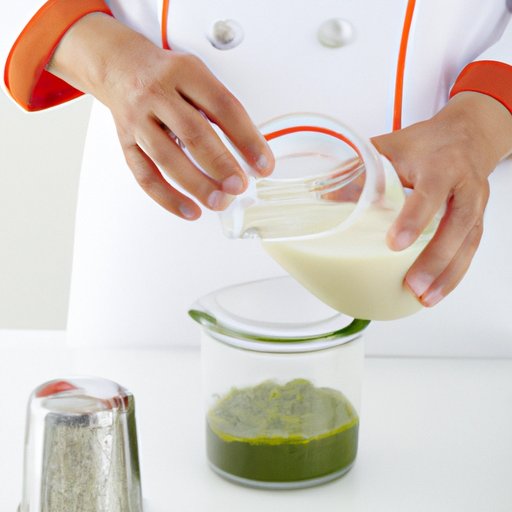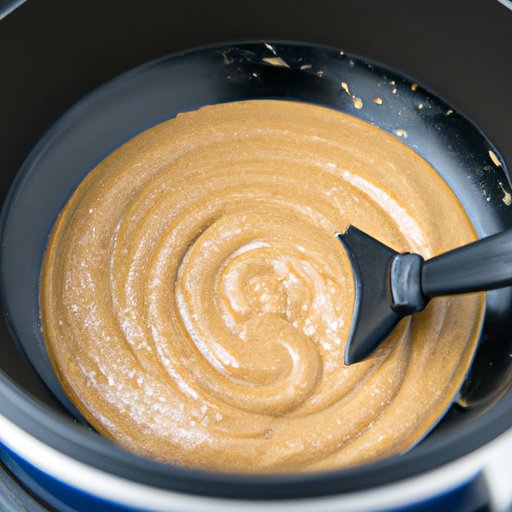I. Introduction
Thin sauce is a common problem faced by many in the kitchen. A sauce with a thin consistency is not only unappetizing but can ruin the overall dish being prepared. Luckily, there are ways to remedy this and create a perfectly thick sauce that is both delicious and visually appealing. This article aims to help solve the problem of thin sauces by providing easy-to-follow techniques.

II. Basic Techniques for Thickening Sauce
Two traditional techniques for thickening sauces are reduction and roux.
- Reduction
Reduction is the natural way of thickening sauces. It involves simmering the sauce over low heat until the liquid evaporates, and the sauce thickens due to the concentration of flavors. The reduction technique may take longer, but it is an effective way of achieving a rich and flavorful sauce.
Step-by-Step Guide:
- Begin by cooking the sauce in a wide saucepan covered with a lid over low heat.
- Remove the lid and stir the sauce every few minutes until it has reduced to the desired consistency.
- Depending on the recipe, some sauces may need to be reduced by up to two-thirds of their original liquid volume.
Advantages: Reduction is a natural way of thickening sauce that results in a rich and concentrated flavor.
Disadvantages: The process of reduction can take longer than other techniques due to the time it takes to simmer the sauce over low heat.
- Roux
Roux is a French technique that involves creating a base with flour and butter and then whisking in liquid to create a smooth and thick sauce. It is an easy and quick way to thicken sauce without the risk of burning or curdling the liquid.
Step-by-Step Guide:
- Melt butter in a pan over low heat.
- Add flour to the pan and whisk to avoid lumps.
- Continue whisking for a few minutes until the mixture turns golden brown, and a nutty aroma is achieved.
- Slowly add liquid to the pan while whisking constantly.
- Continue to whisk until the sauce thickens.
Advantages: Roux is an easy and quick way to thicken sauce without the risk of burning or curdling the liquid.
Disadvantages: Roux can add a slightly grainy texture to the sauce if not whisked correctly.
III. Alternative Thickeners to Flour and Cornstarch
There are several alternative thickeners that can be used instead of flour and cornstarch. These include arrowroot powder, potato starch, and tapioca starch.
Using Arrowroot Powder:
- Mix arrowroot powder with cold water to make a slurry. The ratio of powder to water should be one tablespoon of powder for one tablespoon of water.
- Add the slurry to the sauce and stir well.
- Simmer the sauce for a few minutes until it thickens to the desired consistency.
Using Potato Starch:
Potato starch is an excellent alternative for those allergic to cornstarch.
- Mix potato starch with cold water in a ratio of one tablespoon of starch to two tablespoons of water.
- Add the slurry to the sauce and stir well.
- Simmer the sauce for a few minutes until it thickens to the desired consistency.
Benefits of Alternative Thickeners:
- Alternative thickeners are a great option for gluten-free and cornstarch-free diets.
- They provide a thicker and smoother texture to the sauce.
- They also avoid any flour taste or odor that may not work with the dish.
IV. Herbs and Spices as Thickeners
Certain herbs and spices can be used as natural thickeners for sauces. Like alternative thickeners, they can provide a different texture, aroma, and taste to the dish being prepared.
Herbs and Spices:
- Basil: a great option for tomato-based sauces that require a thicker texture and a punch of flavor.
- Bay Leaves: these can be used in broths to add a thicker texture to soups.
- Cinnamon: a popular spice that can be used in desserts to add flavor and thickness to sauces.
- Thyme: a perfect herb to use in broth-based sauces that require a thicker consistency.
Incorporating Herbs and Spices:
- Add a few leaves or a cinnamon stick to your sauce while cooking.
- Simmer the sauce as you would usually until the sauce reaches the desired thickness.
Importance of Using the Right Amount:
It is important to use the right amount of herbs and spices to avoid overpowering the dish. As thickeners, they should ultimately accompany the flavors and not overpower them.
V. Expert Tips for Choosing the Right Thickeners
The choice of thickener depends on the type of dish being prepared. Here are some tips:
- Type of Dish:
- Biscuits and Gravy: Thickened with a roux or a béchamel.
- Pudding: Thickened with cornstarch.
- Broths: Arrowroot powder or potato starch can provide a thicker texture to broths and soups.
- Stews: Roux or reduction work well for most stews.
- Thickening Levels:
- Alternative thickeners and roux can provide a smooth, thick texture.
- Reduction can result in a much thicker, concentrated sauce.
- Differences in Texture and Taste:
- Roux can provide a slightly grainy texture, while reduction can result in a rich, concentrated flavor.
- Alternative thickeners can provide a smooth texture and have minimal impact on taste.
VI. Fixing a Sauce That Has Turned Out Too Thin
If you find that your sauce has turned out too thin, don’t worry. Several techniques can fix the problem:
- Reduction: Simply continue to cook the sauce over low heat, stirring frequently, until it thickens to the desired consistency.
- Additional Thickener: Use additional thickener, such as flour or cornstarch, mixed with water in a 1:1 ratio to thicken the sauce.
- Cream: Adding cream to the sauce can provide thickness and a creamy texture without adding additional flavor or altering the taste significantly.
Avoid Over-Thickening:
It is important to add the thickener in small amounts and frequently check the consistency to avoid over-thickening the sauce.
Different Thickening Methods for Different Dishes:
Some dishes may require different thickening methods based on the sauce’s flavors or cooking times. It is important to experiment with different techniques to find the method that works best for the dish being prepared.
VII. Common Issues and Solutions
Several common issues may arise when thickening sauces. Here are some solutions to these issues:
- Grainy Texture: This may occur when the roux is not whisked correctly. Solution: Whisk the roux as much as possible to avoid lumps, or consider using alternative thickeners such as arrowroot powder.
- Lumps: Lumps can occur with flours that have not been mixed well with cold water. Solution: Mix flour with cold water and stir well before adding to the sauce.
- Separation: Separation can occur when the sauce is overheated or boiled too quickly. Solution: Lower the heat immediately and whisk the sauce gently to bring it back to its original consistency.
Ways to Avoid These Issues:
- Mix flour well with cold water to avoid lumps or separation.
- Avoid boiling the sauce too quickly.
- Regularly stir the sauce to avoid burning or sticking to the bottom of the pan.
VIII. Adjusting Sauce Thickness for Different Dishes
Adjusting sauce thickness is essential to achieving the desired dish’s consistency. Here are some recipe suggestions that use sauce as a main ingredient:
- Chili: A thick sauce with a slightly spicy flavor works well with hearty meats and vegetables and provides a perfect chili recipe.
- Carbonara: A sauce with a creamy, thick texture works well with carbonara’s pancetta, parmesan, and pasta.
- Gravy: A thick, rich gravy that accompanies meats, potatoes, and vegetables well.
How to Adjust Sauce Thickness:
- For a thinner sauce, add more liquid to the pan.
- For a thicker sauce, try a different thickening method or addition of an alternative thickener.
The Importance of Consistency:
The consistency of the sauce must match the dish being prepared. A thicker sauce works well with meat dishes or pastas, while a thinner sauce complements vegetables or broths.
IX. Conclusion
This article has provided several techniques for thickening sauces to help solve the problem of thin sauces. Basic techniques such as reduction and roux and alternative thickeners like arrowroot powder or potato starch can provide the perfect thickness to any sauce. Expert tips and suggestions on adjusting sauce thickness to suit different dishes and solutions for common issues can help achieve a desired result. By following these tips, you can master the art of creating a perfectly thick sauce.
